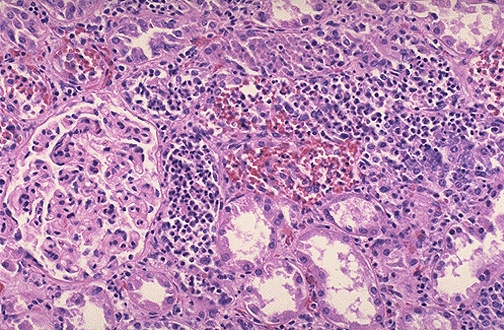
Acute pyelonephritis

Click to see other slides: [1]
A
36 yr old female presented with fever (40 degrees Celsius), chills and rigors
for 2 days. She
had urinary frequency with burning sensation and the urine appeared cloudy.
Mild left costovertebral tenderness was elicited.
1.
What is the most likely pathological process based on the clinical evidence?
Bacteria
infection of the kidneys.
2.
List
the key histopathological features in the slide.
Patchy,
interstitial suppurative inflammation with focal necrosis
3.
Account for the naked eye appearance in the slide.
Aggregation
of lymphocytes produces the naked eye appearance
4.
What
simple test can be performed in the GP�s clinic and what are your expected
findings?
Leukocyte
esterase dipstick to test for pyuria.
Findings should be positive.
5.
What
is the next investigation the GP should ask for and why?
Quantitative
urine culture to confirm the suspicion and antimicrobial susceptibility testing
so that a proper treatment regime can be planned
6.
What
is the gross appearance of the kidney?
Kidney
is enlarged, with depressions due to fibrosis.
Abscesses may be present.
7.
What
is the relationship of the renal lesion to the symptoms of frequency and burning
sensation?
Left costovertebral pain due to stretching of renal capsule as microabscesses form under it.
Symptoms
of frequency and burning sensation are due to infection of bladder and urethra,
causing irritation to these structures.
8.
Do
you expect any long term sequelae?
No.
In uncomplicated pyelonephritis, treatment ordinarily results in complete
resolution of symptoms.
<< PREVIOUS INDEX NEXT SLIDE >>
Copyright � Joseph Ong 2003